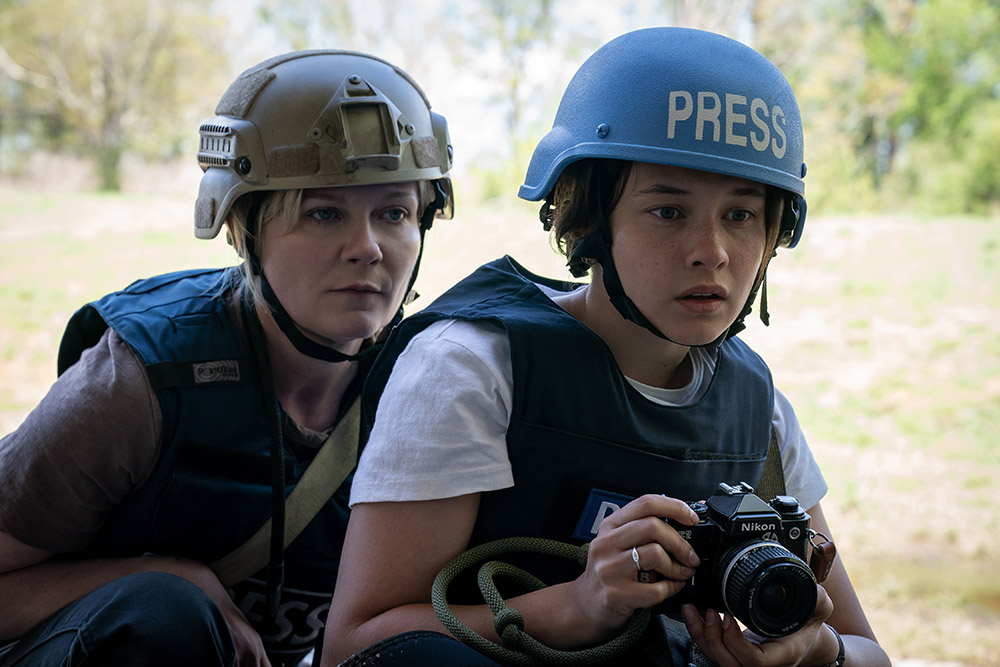
Civil War
Courtesy of A24
[This story contains spoilers for Civil War.]
“The footage you’re about to see may be disturbing.” That content warning, broadcast on the news too often in modern history, was stuck on a loop in the back of my mind as I watched Alex Garland’s latest film, Civil War.
As I sat through the credits, I considered what that warning actually suggests. Yes, it’s a useful way to prepare the viewer for what they’re about to see, but it’s also an invitation to look away, to ignore, to pretend that what happened didn’t happen that way. It’s permission to avoid truth and discomfort.
So, it comes as no surprise then that Civil War should draw controversy, as it washes us, and its central characters, in discomfort with no warning, no invitation to look away, and with no tribe to cling to and tell us what’s right and what’s wrong. Civil War is an abrasive and uncomfortable film, not because it fully subscribes to any particular ideology, but because it doesn’t — and we hate not having clearly defined sides to root for or against or media that doesn’t perfectly align with our worldview so we can walk out of the theater confidently knowing we’re a good person.
As both writer and director, Garland has consistently offered a unique perspective on the human condition, largely devoid of binaries like good and evil that American audiences love to uphold. Garland’s characters are constantly caught between the throes of evolution or death, and sometimes both. That’s certainly the case for Civil War’s central characters, Lee (Kirsten Dunst), a celebrated war photographer who has lost faith in her ability to create meaningful change; Joel (Wagner Moura), Lee’s colleague, who lives for the thrill of being on the front line of history; Sammy (Stephen McKinley Henderson) a veteran journalist who served as a mentor to Lee and Joel, and is all too aware of how little the world changes; and Jessie (Cailee Spaney), a novice war photographer who is thrown into a world she finds both terrifying and electric.
It’s this exploration of death or evolution, within the framework of a highly politicized time in America and an election year no less, that makes Civil War necessary. It’s the future America is looking at right now, death or (re)evolution.
Understandably, viewers have asked whether now is the right time for such a film or if Garland’s claim that it is apolitical is merely an excuse not to stand for anything. On social media, some have worried the film lends legitimacy to right-wing influencer Andy Ngo, who is credited for a few seconds of real-world footage shown in the film, and fear that Garland’s movie endorses the work of The Atlantic journalist Helen Lewis, who is thanked in the credits, and whose views have been criticized by the transgender community.
These are questions I believe the film addresses, though perhaps not in the way some people would like them to be. To paraphrase a quote from the film Lee says to Jessie, the objective of war photography is not to provide answers, but to provide an unaltered image and let the viewer ask the questions. This is what Garland does within Civil War, providing audiences the opportunity for us to ask questions based on what he’s showing us.
I’d argue that the film is actually not apolitical, it’s simply not an exercise in propaganda. It’s naive to believe a film is going to change anyone’s political ideology and suddenly swing the viewer from one side or the other. Garland doesn’t attempt that, but he does offer the chance to evaluate what we believe and why. We’re shown an America torn between the forces of the United States and the secessionists known as The Western Front, comprised of California and Texas. We’re given a President (Nick Offerman) in his third term who has abandoned the American people, committed air strikes against them, and denied journalists any opportunity to tell the truth. Alongside this, police forces have been mobilized, denying resources to civilians while also brutalizing them on the streets. Does that seem like a film waving the flags for MAGA types and fascism?
The demilitarized zones offering aid and food are largely run by and populated with black and brown people. Why is that? Could it be because those are the citizens who also suffer the most as America plays political games and sends minorities off to war for the lie of better careers or more money? Have they decided to sit out a war led by white people because historically they have not seen significant change for themselves within the country their ancestors built? Or are they once again being tasked to rebuild a country, to provide and heal, because no one else will ever step up to do it, even though they never get the support of any governing party in return? The story of Civil War’s America is being told in images that begs these questions, but what isn’t left up to question is that the film is inherently anti-fascist.
So, then the question becomes, is Civil War liberal enough? And it’s that question that I find most interesting because such designators of liberal or conservative are jumbled to the point where not even the soldiers in the film know who they’re fighting. A scene in which two marksmen are pinned to the ground by a sniper hiding in a manor highlights this. The soldiers on the ground, one with dyed hair, and the other with painted blue and pink fingernails, immediately conjuring images of the trans flag, are asked who they’re shooting at. They tell Joel they don’t know; they’re shooting back because they were shot at. Joel asks them if they know the shooter is on the opposite side, and suggests that it might be an ally. And one soldier responds again that he doesn’t know. The shooter fired and now they’re firing back. And the audiences doesn’t know either.
Combatants in fatigues and plain clothes populate both sides, and there are no distinct uniforms to tell us which side is which. Even the film’s clearest antagonist, a racist solider wearing fatigues and red sunglasses, played by Jesse Plemons, isn’t assigned a side, and it’s entirely possible he’s on no side at all, and has simply inserted himself into the conflict to kill, as his hidden pit filled dead bodies covered in lye suggests. These scenes and supporting characters reflect so much of our modern-day political discourse, which is populated by people who come for the necks of their own allies for not entirely subscribing to the most extreme, most perfect form of their ideology.
We see these extremes every day from the serious to the silly: conservatives who want gun control criticized by right-wing extremists who give their children guns for Christmas, liberals who reject other liberals because they weren’t as vocal about one social injustice as they were for another, and grifters who make audacious claims and promise the truth, for a monthly fee. More distressingly, we’re seeing horseshoe theory in action, with supposed liberals saying they’ll vote for Trump after being incensed by Biden’s support of Israel against Palestine, or that they won’t vote at all, as if any such choice allows them a moral high ground that absolves them of any further suffering people will endure.
We form our personalities around these ideologies and become so enmeshed in them that we start to lose sight of what we stand for, and who our allies and enemies really are until it all dissolves into chaos.
While I am personally unbothered, I found it interesting that I couldn’t even talk about this movie on socials without a couple of people insinuating I, a Black writer who is vocally liberal, was supporting a film that supports neo-Nazis. Does an obligatory, and legally necessary credit of Andy Ngo, for the use of seconds of footage that shows where America’s conflict resides mean Garland supports him? Does a thank you in the credits to a controversial journalist whose right-wing writing undoubtedly informed Garland’s thinking while making Civil War suggest the film is aligned with TERFism? Or is Garland’s film merely showing us images, all the way through the credits, that force us to ask questions of whether the acknowledgment of work we don’t agree with means the entire endeavor is worthless and contains no truth in which we can acknowledge?
Garland recently stated he’ll somewhat pull back from directing for the foreseeable future, with his comments sharing interesting parallels with Civil War’s Lee. Dunst portrays her with no light in her eyes, especially when compared to her colleagues Joel and Jessie. She observes but rarely reacts, and flashbacks show her photojournalism abroad, capturing the horrors of war which she hoped would get through to Americans and prevent them from ever falling prey to such atrocities. Yet her photography, award-winning as it is, didn’t prevent war, and thus her career is defined by inaction, her inability to get directly involved in conflict, and an inability for her skillset to help others avoid conflict.
Thus, she moves through the film like a zombie, not the only Romero-inspired element in the film, which is noteworthy given Garland’s big Hollywood break was writing 28 Days Later (2002). And in some ways, much as Garland has evolved over the decades, Civil War goes back to that film, which saw its characters caught in a dying society, unsure of who to trust, and lacking confidence that we can still make a difference.
The footage we see in Civil War may be disturbing. But the biggest question that looms over all of those images is still up in the air. Was any of it disturbing enough to prevent a real Civil War in our time, or will we simply judge the artistry of the images, the craft of the photographer while we stagger ahead, avoiding discomfort and hard questions because we only want to acknowledge works that assures us we’re on the right path, that hope springs eternal, and such a thing could never happen in reality because surely we know who our allies and enemies are. And if the controversy and judgments made outside of watching Civil War prove anything, it’s that Alex Garland’s cinematic perspective on America undeniably makes him an enemy ally. Doesn’t it?









